Barging through Belgium on the Shoe: part 2
When we arrived in Veurne, we made contact with an English couple on a beautiful Dutch tjalk moored at the beginning of the pontoon where we also found our shady spot. They kindly advised us there was plenty of space and helped us locate the harbour master's office where we could pay our dues and get the electricity connected. On our last morning, they came by with their gorgeous old dog, Bilbo, and I discovered that we two ladies were both members of the Facebook Women on Barges and had, in fact, 'known' each other for years. Lisa is also a fellow scribe and has written three books about their life and travels in France. You can find them on Amazon here.
It was really lovely to chat about our common interests and I was sorry we weren't able to spend more time with them, but we had to leave before overstaying our time in the marina. We didn't manage to take a meet up 'selfie' either, but I did take a photo of their lovely barge as we fared past it on our way to the Lo Canal.
In brief, we planned to do a loop, going south from Veurne to the village of Fintele (pronounced Fintayla) and then heading east on the Ijzer river before turning south again into the canal to Ieper (Ypres). After that we would reverse our steps (figuratively of course) and go north to Diksmuide. But that's not exactly how it went, as you're about to read.
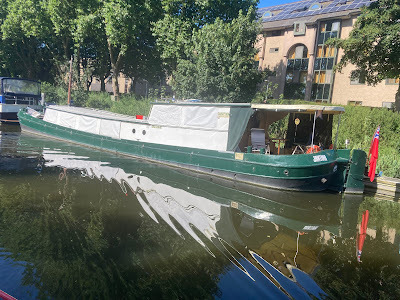 Lisa and her husband's lovely barge
Lisa and her husband's lovely bargeFrom Veurne, the Lo Canal extends about 14.5 km to Fintele where a lock takes the boater up into the Ijzer river. For such a short distance, it was a surprisingly eventful day and involved another (not so) comedy act.
We'd not long been through the first of the lifting bridges on the way out of Veurne when, in a moment of distraction, Koos didn't realise the Hennie H was veering to the left of the canal. Unlike me, who tends to steer the way I'm looking, Koos's attention was caught by something on the right bank so he didn't notice our progress towards inexorable disaster.
"Koos, err, keep steering," I reminded him. And then, "Koos! Watch out! There's a .... !"
Too late.
Seconds later, we were ploughing into the low-hanging branches of a large tree for which our lovely shady umbrella was no match. Snap, it went, and collapsed. Onto me.
I was instantly enveloped in folds of fabric while trying to hold on to the umbrella's central pole, which was hanging over the railings around the stern of the boat. Oh dear. After scrambling clear of my shroud, Koos and I succeeded in pulling it in without further mishap.
"I'm afraid it's a gonner," said Koos, staring sadly at the twisted mounting and cracked umbrella mechanism. "I might be able to fix it, but not now."
This was the third drama we'd had with umbrellas since we started faring, but it was the first time we'd lost one through an argument with a tree; quite surprising really, given the rural waterways we like exploring. It certainly gave a new dimension to our maxim 'Keep steering'. That's one distinct downside of the Hennie H. We simply can't afford to get distracted, as our fickle old lady will take advantage of any loss of focus to dance off in the wrong direction.
If you see the photos below, the top one still shows the edge of the umbrella on the upper left-hand side of the picture. The next one was taken less than an hour later, when I'd already rigged up some improvised sun protection for Koos with a normal umbrella strapped to his chair on a boat hook. Our poor wrecked parasol was relegated to a recumbent position on the roof.
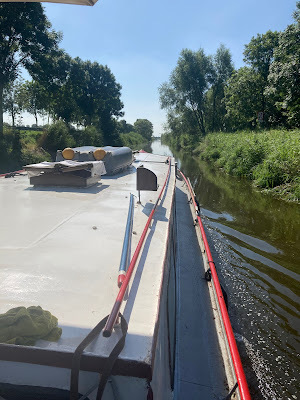
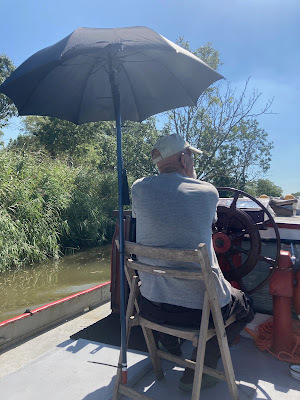
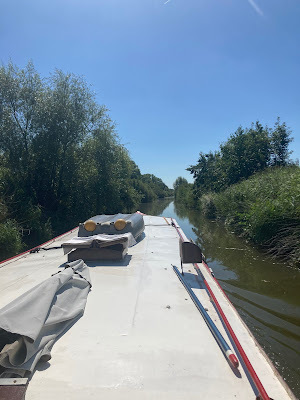
It wasn't long, however, before the heat was becoming just too much. The temperature was well over 30C and we were roasting on our steel decks. I'd moved Zoe into the only shady area next to the steering wheel, but that didn't help us. Koos had had enough, so when he spotted a bank of reeds in the shadow of some trees, he decided that was where we were going to rest up, come what may.
"But there's nothing to tie up to," I said, a little confused."Wait and see," was all I got in reply.
While I watched, Koos gathered two clumps of reeds together, wound some thin rope around them and secured the rope to the handrail on the roof of the Hennie H. On such a quiet canal, this was enough to keep us from floating away and we retreated below to have a break. Clever, eh? Reeds are pretty strong and even more so when bunched together.
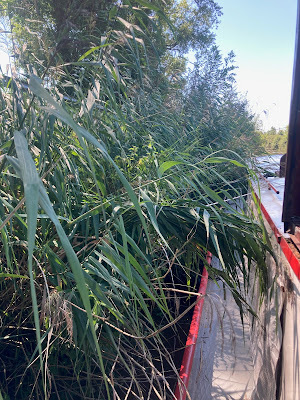 Tied to the reeds on the Lo Canal between
Tied to the reeds on the Lo Canal betweenVeurne and Fintele
An hour later, the sun had moved round and the shade had all but disappeared. It was time to move on, although not far. Within a few kilometres, we were below the lock at Fintele and moored up to the pontoon for boats waiting to go through to the river. With a maximum time limit of 24 hours, it seemed like the place for us to spend the night, especially as I knew we'd soon be out of the westward moving sun. Relieved to be somewhere with easy access to land, I hopped off and took Zoe for a walk.
Fintele was evidently a popular place for day trippers, as there were three restaurants, all of which seemed to be busy. Other than that, it boasts a few houses, some good moorings for pleasure craft on the river and not much else. During the evening, Koos and I went for another walk with Zoe and met a couple who told us about the de hooipiete.
Up until the 1990, they told us that local farmers used to erect a wooden bridge over the Ijzer river every April to give them easy access to their pastures on the opposite bank where they took their cattle and collected the hay (hooi). Come October, they would take it down again and leave the river free for the boats to pass through. This movable bridge (in west Flemish, piete) was built so that sections could be removed if a boat needed passage, but when pleasure boating became so much more popular, it was decided to remove it permanently and it was last taken down in 1990.
"The old hooipiete is over there," the couple said, pointing to the long grass next to the restaurant of the same name. Sure enough, a large rectangular platform made of planks was lying in the grass straddling a small ditch. Sadly, I didn't have a camera with me so I didn't take a photo, so here's an old image I found on the internet of the bridge in place over the Ijzer.
 The hooipiete
The hooipieteAnother happy discovery was that, contrary to expectations, we could turn right out of the lock and follow the river upstream to (almost) the French border. On our waterways map, the upper Ijzer was marked as unnavigable and we'd assumed we couldn't explore it. However, the lock keeper at Fintele assured Koos it was no problem; that the authorities had cleaned it up and we should be able to go through as far as Roesbrugge, after which the river into France is only fit for canoes. Anyway, we knew one other couple who'd (possibly) done that stretch but their boat is much shorter than ours, so we needed to be sure we could turn around and come back given that we couldn't go on into France. The reassurance from the lock keeper, added to Koos's research in finding possible turning points convinced us to go; hence our diversion from the original plan. The only remaining uncertainty was whether we could pass under the first wooden footbridge. In principle, bridge could be lifted, but it was apparently in need of repair and although opening was possible, they couldn't close it again. We would see.
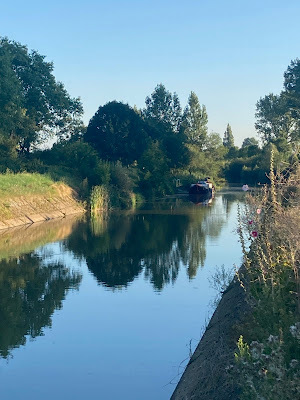 Moored to the waiting pontoon. Photo taken
Moored to the waiting pontoon. Photo takenin the morning from the bridge over the lock.
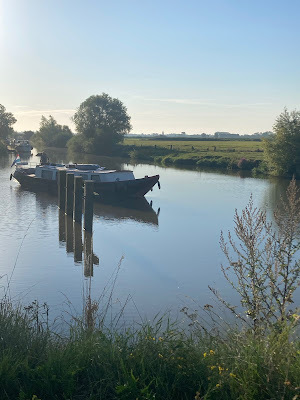 We left early so we could be sure of
We left early so we could be sure of mooring up before the promised 35C got to us
It was eight o'clock the next morning when I took the photo above of Koos turning onto the river. I'd taken Zoe for her walk and, knowing there were moorings on the river, I'd asked him to pick me up there after he'd been through the lock. It was a glorious sunrise and the day started well with a delightful French couple helping Koos hold the Hennie H while I climbed on board with Zoe. I should mention she (Zoe) had been a little gem ever since we left, taking everything in her stride and accepting faring life without complaint or question. She genuinely seemed to enjoy all the new walks, sniffs and encounters we had, but this day would be a challenge as we knew the temperatures were going to soar.
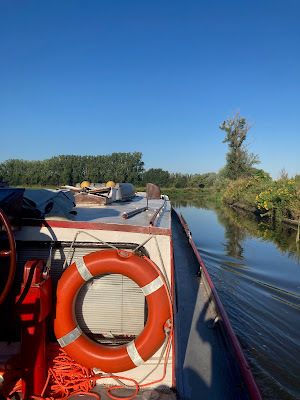
The upper Ijzer was truly lovely: rural, unspoilt, and with barely a building in sight. We went under the doubtful bridge with room to spare and from there on it was pure joy. I could well imagine the beauty of misty mornings over the land as the scenery has a kind of fenland air to it.
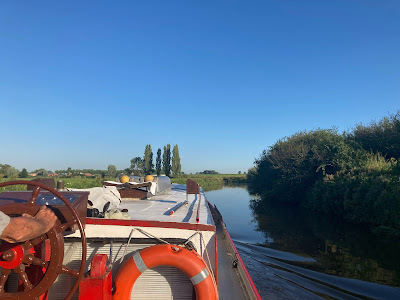
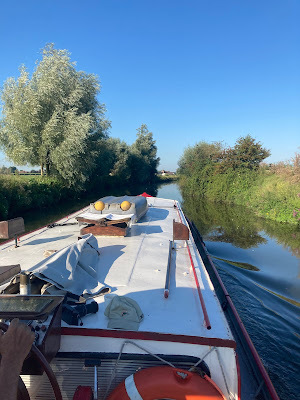
After more than an hour's gentle faring, we arrived at the village of Stavele (pronounce Stavuller) where moorings on both sides of the lifting bridge offered us good spots for a rest break. Initially, we stopped on the east side (see the photos below), but we soon moved to the pontoon on the west in the shade. After a short walk in the village, which was in siesta mode despite being mid-morning, we retreated inside and it wasn't long before Koos and Zoe were sending up zzzzzzs in unison
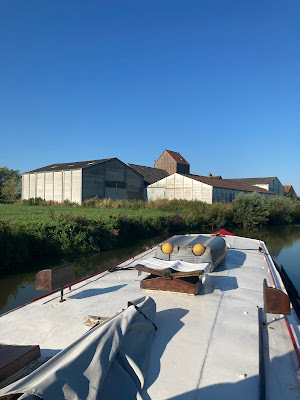 Approaching Stavele
Approaching Stavele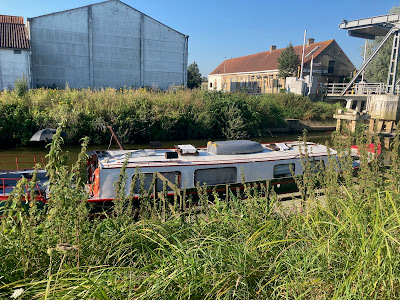 Mooring on the east side of the bridge
Mooring on the east side of the bridge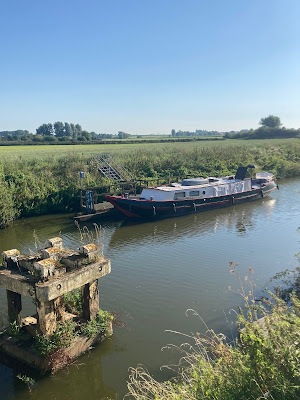
Before leaving, we took another walk along the towpath, which was more of a narrow track at this stage. It was interesting to find an information board describing the agricultural and market produce barges that used to frequent Stavele and also the flooding issues they experienced in the area due to the number of water courses that drain into the river there. Unfortunately, commercial barges stopped coming to the village in the 1970s (if I've managed to decipher the text correctly).
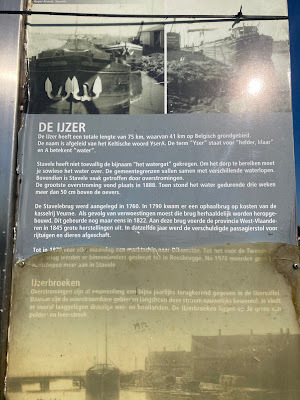
By midday, we'd completed the twelve kilometres to Roesbrugge and now it was time to find a spot to sit out the heat; we could both feel the thermometer was climbing steadily. To our huge relief, we found a long pontoon that extended below the bridge to the other side. Just perfect for us.
"We'll just go beyond the bridge," Koos said. "The place I saw on Google Earth is just a little way ahead and we should be able to turn easily there. As it happened, easy wasn't quite the word I'd have used. There was indeed an opening into the Dode Ijzer (a dead arm of the river), but it was both very narrow and shallow. Added to the challenge was our little barge's left turning propellor meaning she always veers to the right in reverse. Not handy when needing to reverse to the left.
This is where Koos's patience is at its supreme best. He pushed the Hennie H's nose into the gap and going backwards and forwards in tiny steps, he succeeded in doing a one-hundred-and-plenty-point turn to get us facing back the way we'd come. My job was to shout warnings about mud, logs and other debris we churned up in the process. A good twenty minutes later, we were tied up to the pontoon under the bridge where we were at least mostly in the shade, but also with a prevailing pong that we thought was the result of our dredging activities.
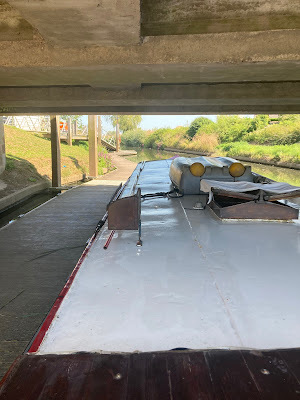
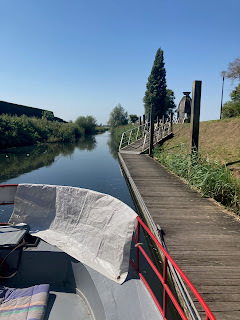
Luckily for our guilty complexes, this was not the case, but I'll continue with the story in the next episode, when I'll hopefully get us a bit further and be able to tell you about our visit to Ieper and Diksmuide.
Have a lovely week allemaal, and I hope you enjoy the changing seasons wherever you are.



